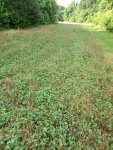As a retiree, I have almost all the resources needed to make the almost perfect hunting property (meaning lots of time, no-till drill, firminator, dozer, etc.). What I don't have is proper knowledge....so, my plea is where did you guys learn all this food plot stuff? My local feed & seed contact tells me how much chemical to spray, and sells it to me, then I chicken out and don't spray a pre-emerge (Prowl) 'cause I'm afraid the seeds I plant won't make it up any better than the grasses and weeds I'm attempting to control. About all I've learned in two-three years trying this is to burn a plot down with gly, burn a woody bush down with Remedy and hope for the best. I've planted over two hundred trees and wound up killing some with chemicals. I've got roughly 15 acres in food plots that I work on alone, and I am becoming convinced some people just can't get it.
Two of the plots (bout 4 acres) are very sandy. County agent told me to build soil through bio-mass rotations, etc. ( re no-till drill), and I've poured heart and soul into it...still sucks!!! Where do I go to get educated?
Two of the plots (bout 4 acres) are very sandy. County agent told me to build soil through bio-mass rotations, etc. ( re no-till drill), and I've poured heart and soul into it...still sucks!!! Where do I go to get educated?


